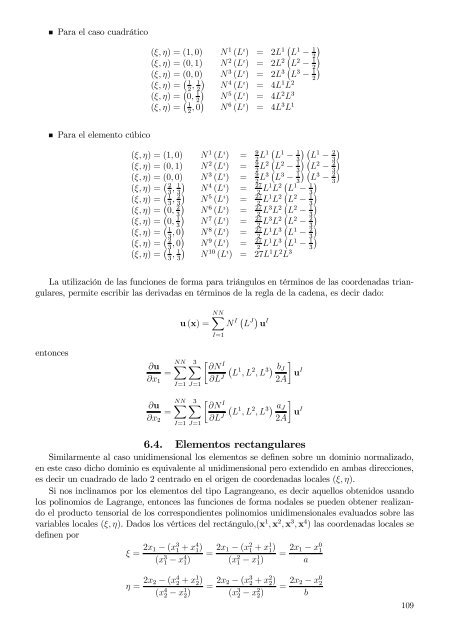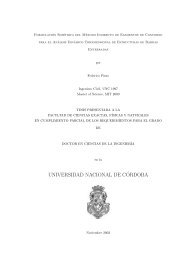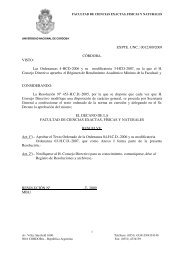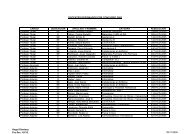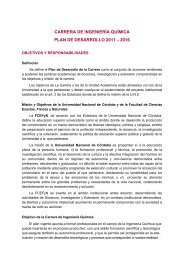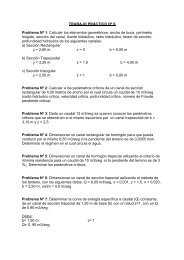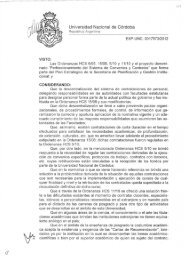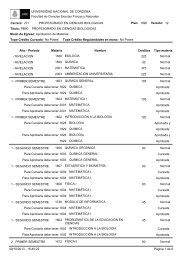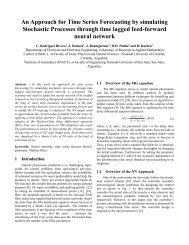Capítulo 1 Métodos de residuos ponderados Funciones de prueba ...
Capítulo 1 Métodos de residuos ponderados Funciones de prueba ...
Capítulo 1 Métodos de residuos ponderados Funciones de prueba ...
Create successful ePaper yourself
Turn your PDF publications into a flip-book with our unique Google optimized e-Paper software.
Para el caso cuadrático<br />
(ξ, η) = (1, 0) N 1 (L ı ) = 2L ( )<br />
1 L 1 − 1 2<br />
(ξ, η) = (0, 1) N 2 (L ı ) = 2L ( )<br />
2 L 2 − 1 2<br />
(ξ, η) = (0, 0) N 3 (L ı ) = 2L ( )<br />
3 L 3 − 1 2<br />
(ξ, η) = ( 1<br />
, )<br />
1 N 4 (L ı ) = 4L 1 L 2<br />
2 2<br />
(ξ, η) = ( )<br />
0, 1 N 5 (L ı ) = 4L 2 L 3<br />
2<br />
(ξ, η) = ( 1<br />
, 0) N 6 (L ı ) = 4L 3 L 1<br />
2<br />
Para el elemento cúbico<br />
(ξ, η) = (1, 0) N 1 (L ı ) = ( ( )<br />
9<br />
2 L1 L 1 − 3) 1 L 1 − 2 3<br />
(ξ, η) = (0, 1) N 2 (L ı ) = ( ( )<br />
9<br />
2 L2 L 2 − 3) 1 L 2 − 2 3<br />
(ξ, η) = (0, 0) N 3 (L ı ) = ( ( )<br />
9<br />
2 L3 L 3 − 3) 1 L 3 − 2 3<br />
(ξ, η) = ( 2<br />
, )<br />
1 N 4 (L ı ) = 27 3 3<br />
2 L1 L ( )<br />
2 L 1 − 1 3<br />
(ξ, η) = ( 1<br />
, )<br />
2 N 5 (L ı ) = 27 3 3<br />
2 L1 L ( )<br />
2 L 2 − 1 3<br />
(ξ, η) = ( )<br />
0, 2 N 6 (L ı ) = 27 3<br />
2 L3 L ( )<br />
2 L 2 − 1 3<br />
(ξ, η) = ( )<br />
0, 1 N 7 (L ı ) = 27 3<br />
2 L3 L ( )<br />
2 L 2 − 2 3<br />
(ξ, η) = ( 1<br />
3 , 0) N 8 (L ı ) = 27 2 L1 L ( )<br />
3 L 1 − 2 3<br />
(ξ, η) = ( 2<br />
, 0) N 9 (L ı ) = 27 3 2 L1 L ( )<br />
3 L 1 − 1 3<br />
(ξ, η) = ( 1<br />
, )<br />
1 N 10 (L ı ) = 27L 1 L 2 L 3<br />
3 3<br />
La utilización <strong>de</strong> las funciones <strong>de</strong> forma para triángulos en términos <strong>de</strong> las coor<strong>de</strong>nadas triangulares,<br />
permite escribir las <strong>de</strong>rivadas en términos <strong>de</strong> la regla <strong>de</strong> la ca<strong>de</strong>na, es <strong>de</strong>cir dado:<br />
u (x) =<br />
NN∑<br />
I=1<br />
N I ( L J) u I<br />
entonces<br />
∂u<br />
NN∑<br />
=<br />
∂x 1<br />
I=1 J=1<br />
∂u<br />
NN∑<br />
=<br />
∂x 2<br />
I=1 J=1<br />
3∑<br />
[ ∂N<br />
I<br />
3∑<br />
[ ∂N<br />
I<br />
∂L J (<br />
L 1 , L 2 , L 3) b J<br />
2A<br />
∂L J (<br />
L 1 , L 2 , L 3) a J<br />
2A<br />
]<br />
u I<br />
]<br />
u I<br />
6.4. Elementos rectangulares<br />
Similarmente al caso unidimensional los elementos se <strong>de</strong>finen sobre un dominio normalizado,<br />
en este caso dicho dominio es equivalente al unidimensional pero extendido en ambas direcciones,<br />
es <strong>de</strong>cir un cuadrado <strong>de</strong> lado 2 centrado en el origen <strong>de</strong> coor<strong>de</strong>nadas locales (ξ, η).<br />
Si nos inclinamos por los elementos <strong>de</strong>l tipo Lagrangeano, es <strong>de</strong>cir aquellos obtenidos usando<br />
los polinomios <strong>de</strong> Lagrange, entonces las funciones <strong>de</strong> forma nodales se pue<strong>de</strong>n obtener realizando<br />
el producto tensorial <strong>de</strong> los correspondientes polinomios unidimensionales evaluados sobre las<br />
variables locales (ξ, η). Dados los vértices <strong>de</strong>l rectángulo,(x 1 , x 2 , x 3 , x 4 ) las coor<strong>de</strong>nadas locales se<br />
<strong>de</strong>finen por<br />
ξ = 2x 1 − (x 3 1 + x4 1 )<br />
(x 3 1 − x 4 1)<br />
= 2x 1 − (x 2 1 + x1 1 )<br />
(x 2 1 − x 1 1)<br />
= 2x 1 − x 0 1<br />
a<br />
η = 2x 2 − (x 4 2 + x1 2 )<br />
(x 4 2 − x 1 2)<br />
= 2x 2 − (x 3 2 + x2 2 )<br />
(x 3 2 − x 2 2)<br />
= 2x 2 − x 0 2<br />
b<br />
109


